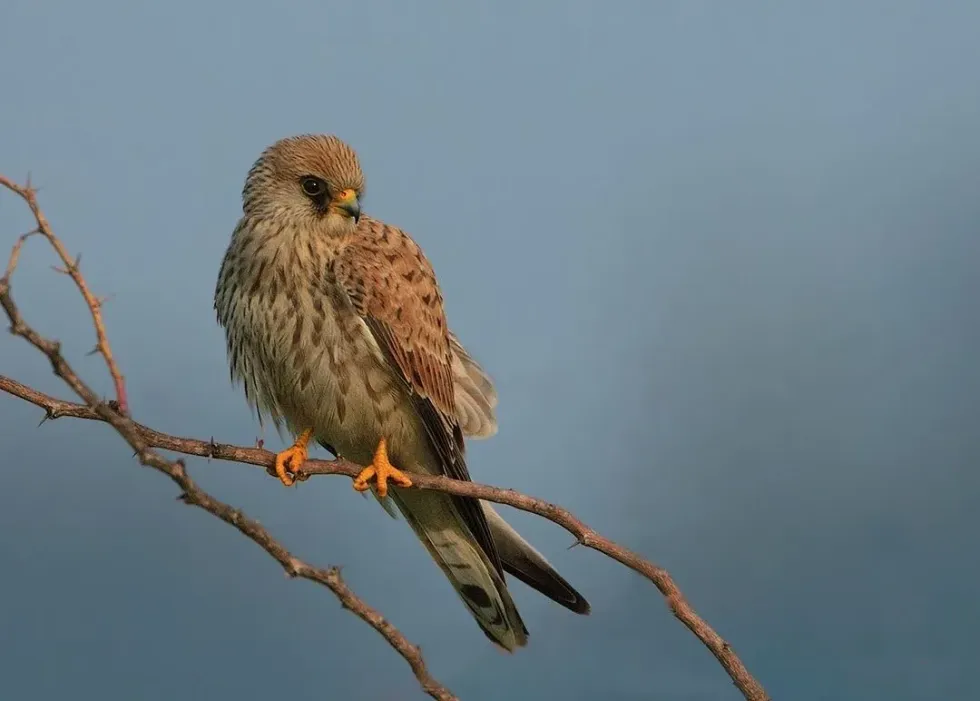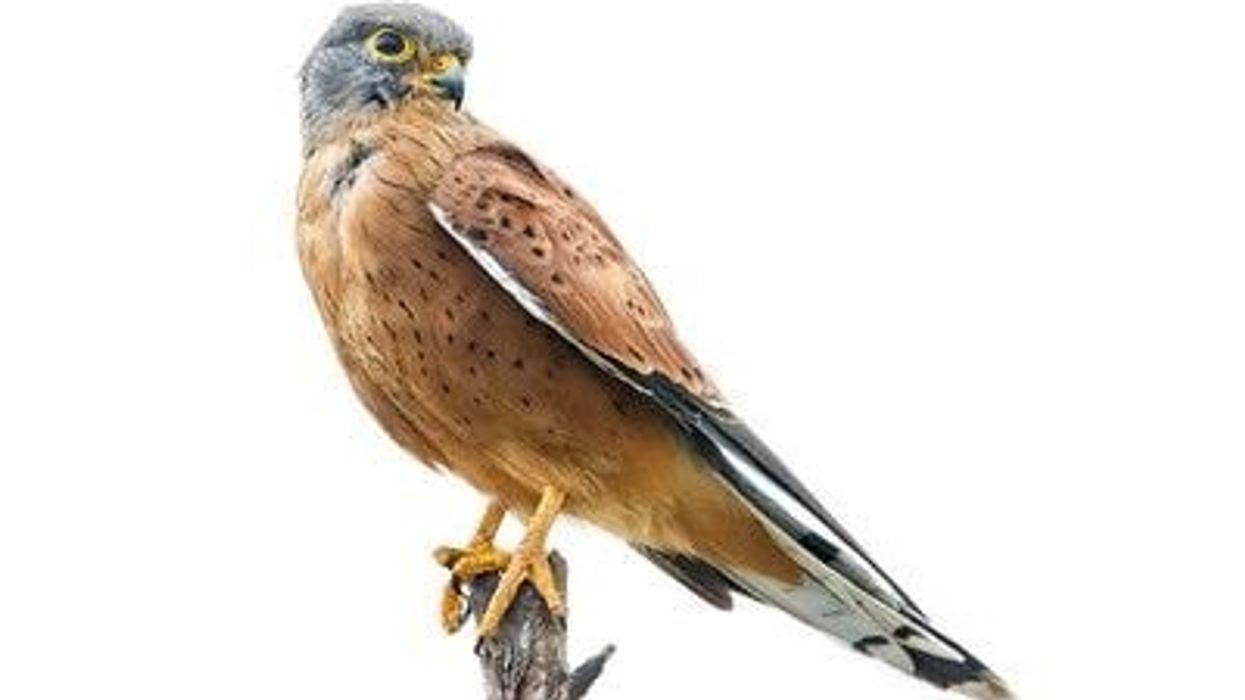There are a total of 40 species of falcons in the world. Under the falcon subspecies come kestrels.
There are various types of kestrels including the common kestrel, American Kestrel, Nankeen kestrel, and greater and lesser kestrel among others. The Lesser Kestrel, Falco naumanni, is a small falcon species. Lesser is a word attached to species that are either a minor species or small in size like the lesser Kestrel.
The Lesser Kestrel is seen in Europe, Central Asia to China, and migrates to parts of Africa during wintering range occurs in other parts. They are relatively larger birds as compared to other species.
They are territorial and can attack as well. Such species are rarely seen near human habitation or settlements unless they find prey. They are carnivores and feed on small birds, insects, reptiles, and rodents.
This article will look at some fun and interesting facts about these predatory birds that are small yet powerful. If you like this article, then visit our Swallow-Tailed Kite and palm-warbler facts too.
Lesser Kestrel Interesting Facts
What type of animal is a Lesser Kestrel?
The Lesser Kestrel, Falco naumanni, is a type of falcon bird species of animal that belongs to the order Falconiformes.
What class of animal does a Lesser Kestrel belong to?
The Lesser Kestrel is a type of small falcon bird that belongs to the class Aves, family Falconidae, and genus name Falco.
How many Lesser Kestrels are there in the world?
The world population of Lesser Kestrel, Falco naumanni, is estimated at 50,000-60,000 as of 2005. The figures may vary greatly in recent times.
The Lesser Kestrel - Greece is considered endangered because its habitat is under threat. They are classified as Least Concern species and not under threat. The Lesser Kestrel is rare north of its breeding range and declining in its European range.
Where does a Lesser Kestrel live?
Lesser Kestrels live in the wooded region and bushed region, open grasslands, and cultivations. They are majorly carnivorous and stay in regions where they can find their prey easily.
They live in altitudes of 500 m above sea level. For wintering grounds, these bird species prefer grounds in West Africa. Lesser Kestrels favor a latitude belt through Senegal where they find appropriate prey including locusts and grasshoppers.
What is a Lesser Kestrel's habitat?
The Lesser Kestrel, Falco naumanni, is a summer migrant species and its habitats are primarily in bushed, wooded, and open grassland areas.
They don't build nests in wintering grounds however they choose sites on mountain slopes and other terrains. If you wish to find out more about their habitat range login to the eBird website on your phone and refer to the Lesser Kestrel range map that will assist you to spot them right in the first instance.
They have spent wintering in Africa and lived in parts of Europe, Asia, and other parts of the world at other times.
Who do Lesser Kestrels live with?
They are found in flocks s 40-50 birds during migration but also individually near other species of their kind. They are territorial beings and maintain strong bonds. They coexist with other species in the wild.
How long does a Lesser Kestrel live?
The Lesser Kestrel lives up to seven years of age. The oldest recorded falcon species was a peregrine falcon that lived for 19 years and nine months in Minnesota in 2012.
How do they reproduce?
The Lesser Kestrel male-female breeding season is usually from March to June and breeds in colonies. Kestrels' mating happens sexually and they don't build a nest structure and lay eggs in breeding ranges and declining mountain ranges, scrapes in trees, tree holes, old buildings, and other such spaces as nest sites.
Females are more prominent in building nesting sites as compared to other species. Lesser Kestrel males and females mate and then the females give birth to four to six eggs.
The incubation period lasts 28-31 days in which the first three eggs hatch on the first day followed by the other eggs in subsequent days.
This ensures there is no sibling rivalry between the nestlings. Parents feed the young until they become independent and are ready to leave their nest.
What is their conservation status?
The Lesser Kestrel species are classified as Least Concern species by the International Union For Conservation Of Nature (IUCN) list.
Lesser Kestrel Fun Facts
What do Lesser Kestrels look like?
The Lesser Kestrels are small falcon species with broad black terminal bland and a long tail. They have sharp claws to catch prey and are white. The species has sexual dimorphism.
Male Lesser Kestrel species have a chestnut back, blue grayish crown, and a rump. They have light underparts. They have a gray head and tail with bright yellow eye-ring and their eyes are dark in color.
The Brown Lesser Kestrel wingspan is 25-28 in (64-72 cm). Their wing feathers are more rounded and shorter and their wing color is gray. They are winter migrants in Africa including countries like Kenya.
How cute are they?
The Lesser Kestrel is a majestic and beautiful being. Adult species are not exactly cute however, the juvenile species are cute since they are small in size. The juveniles are never seen out in the open since they build nest structures in high elevations. Did you know that American Kestrels are the smallest falcon species in North America?
How do they communicate?
They make use of a series of communication techniques including calls, visual, acoustic, and chemical. A 'kee-kee-kee' sound is how they are identified best. They also communicate via body language to other species.
How big is a Lesser Kestrel?
The lesser kestrel is 11-13 in (27-33 cm) in length which is much bigger than the British bird, also known as the national bird of Britain, the European Robin at 4.7-5.5 in (12-14 cm).
How fast can a Lesser Kestrel fly?
They can fly at a cross-country speed of 13.1 mph (21.13 kph) along commuting flights at an altitude of 491-539 ft (149.7-164.4 m). These falcon species are capable of detecting prey in flight as well.
How much does a Lesser Kestrel weigh?
Lesser Kestrel weighs 0.33 lb (150 g). Gyrfalcon is the largest falcon species and weighs 3.1 lb (1.4 kg).
What are the male and female names of the species?
Male falcons are called tercel and females are called falcons. Females tend to be smaller in size as compared to males due to sexual dimorphism.
What would you call a baby Lesser Kestrel?
A baby lesser kestrel is referred to as a chick or more popularly as an eyas pronounced 'aiy-ass' until they have grown up to be independent. In the initial few weeks of development, they are completely dependent on their parents.
What do they eat?
The Lesser Kestrel diet is carnivorous. Kestrels are seen consuming invertebrates including flying insects.
A Kestrel can spot a beetle from 50 m away. They are also capable of seeing ultraviolet light helping them trace urine trails left by rodents and other prey species to follow and attack. They usually drop vertically towards the ground grab their prey and kill it with a bite.
Are they poisonous?
No, they are not poisonous however they can be dangerous given they have sharp claws and a beak that is capable of biting. They are seldom seen near human settlements however if you spot one, it's safe to keep a distance while observing them.
Would they make a good pet?
No, they are innately wild beings hence they thrive best in the wild in their natural habitat. They are not easy to take care of as compared to various other species of pet animals.
Did you know...
The falcon is the national bird of the United Arab Emirates, Qatar, Oman, and several other regions. This recognizes the importance of falconry in Arab traditions.
A research paper titled 'A molecular phylogeny of African Kestrels with reference to divergence across the Indian Ocean' is published on research gate under the head of molecular phylogenetics and evolution. It examines evolutionary relationships, phylogenetic placements, and other such topics about the same in detail.
If you are interested do give the paper a read to understand their movement and pattern.
What survival mechanisms do Lesser Kestrels have?
Their instant response to any danger is their flight instinct. They protect their young ones by placing them in nest cavities far from possible predators. Their nest placement does most of the work for these species to protect the young. Killing such species by hunting and poaching is illegal in most places and they possess legal protection.
What is unique about the Lesser Kestrel?
The species' name commemorates Johann Fredrich Naumann a German naturalist. They are similar to other species of Kestrel however all species of kestrels have slight differences.
The female Lesser Kestrel has an indistinct mustache unlike other species of Kestrel and they also possess amazing eyesight. They are often confused with the common kestrel.
Common vs Lesser Kestrels is different species from the same family. Some differences include their tail.
The Lesser Kestrel has more pointed and broad tail feathers as compared to the common kestrel whose tail is more aligned and rather straight. The seventh primary wing is shorter than the tenth in the left kestrel and in the common Kestrel, the seventh and tenth wing feather is the same length.
The Lesser Kestrel's face is darker as compared to the common kestrel and its features are closer. Apart from this, the Lesser Kestrel has spotless upper parts as compared to common kestrels that have spotted upper parts.
If you wish to see these beautiful species you could visit the Lesser Kestrel in Kaziranga National Park a world heritage site located in Assam, India. If you cannot visit, search for a falcon species native to your region and pay a visit to them to see these majestic beings.
Here at Kidadl, we have carefully created lots of interesting family-friendly animal facts for everyone to discover! Learn more about some other birds from our common-nighthawk facts and American bittern fun facts pages.
You can even occupy yourself at home by coloring in one of our free printable Lesser Kestrel coloring pages.










